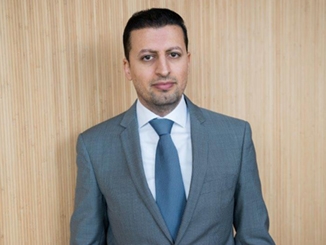From oil and gas companies escaping exclusion via sustainability-linked bonds, to sovereigns offering greater liquidity via green bonds, Actiam head of fixed income Mehdi Abdi is heartened by key developments in sustainable bonds – although issuers may find him increasingly picky.
Shruti Khairnar, Sustainabonds: Actiam is an established investor in the sustainable bond market, with around €1bn of assets in green, social and sustainable bonds. What can you tell us about the latest developments in your investment strategy?
Mehdi Abdi, Actiam: This year, we’ve optimised our sustainable investment policy regarding the exclusion of the so-called “at-risk” companies within fixed income. We have a proprietary ESG scoring methodology that gives every company a score between zero and 100. This score is based on quantitative screening that considers sustainability-related risks. The higher the score, the better prepared are companies for a transition to a sustainable society. And if the score is low, reflecting high risk, the company is deemed at-risk.
 In the beginning, we decided to exclude all names that scored below 20. But recently, we have said that at-risk companies, companies which in essence can make the change, should make changes to become “not at risk” in the future by improving their contributions towards the Sustainable Development Goals (SDGs). The good thing now for at-risk companies is that if they do make changes in the coming year, the label can be changed, and they will again be investable for us.
In the beginning, we decided to exclude all names that scored below 20. But recently, we have said that at-risk companies, companies which in essence can make the change, should make changes to become “not at risk” in the future by improving their contributions towards the Sustainable Development Goals (SDGs). The good thing now for at-risk companies is that if they do make changes in the coming year, the label can be changed, and they will again be investable for us.
Khairnar, Sustainabonds: Speaking of at-risk or brown companies, Repsol recently came out with a transition framework including use of proceeds and sustainability-linked bonds. What is your opinion on such companies trying to make the transition?
Abdi, Actiam: We are supportive of new issuers coming to the green and sustainable market, whether it is Repsol or another oil and gas company. We do our own analysis, anyway, so each framework that comes to the market is assessed by our sustainability team. Even when some issuers label their bonds as green in the market, we are sometimes stricter (based on our sustainable investment policy and our fundamental investment principles) and may not agree with that, or we don’t label that as a green bond. So, each issuer/issuance is internally verified and we decide whether this company is included in our investable universe.
All bonds in our investable universe receive our ESG score, and green, social and sustainable bonds get the highest score if our sustainability team concludes the assessment positively. So, from a portfolio management perspective, it becomes interesting to invest in those green, social and sustainable bonds, because besides financial outperformance targets we also have to outperform the benchmark on ESG factors. Our clients value that social and financial returns go hand in hand at Actiam, so even more reason for us as portfolio managers to invest in sustainable bonds.
Khairnar, Sustainabonds: Sustainability-linked bonds have grown strongly in the past year. Do you find these instruments interesting for your portfolio?
Abdi, Actiam: At Actiam, we aim to contribute to achieving the SDGs, so we definitely support a lot of new initiatives in the market and especially sustainability-linked bonds (SLBs). We have participated in deals such as those from Eni, Tesco and Femsa.
The Eni SLB is a good example of a company that has listened to its stakeholders. Eni has an at-risk status within Actiam, which means that we cannot invest in the company at the moment. However, this could change in the future if it works and makes changes within the company. The reason why Eni is at-risk is because its carbon footprint is larger than the industry average, and its investments in sustainable energy sources was lower. However, it has recently launched a new sustainability framework, in which it has included new KPI targets that should accelerate the reduction of their carbon footprint. And for the bonds issued under this framework, Eni has a strong commitment to achieve those sustainable goals. If they do not, there will be a penalty of a higher interest rate. We have therefore decided to waive the at-risk status, because in the long term, these bonds are equipped to help the company transition. So we have therefore invested in its SLB.
I believe sustainability-linked bonds are a good instrument to have in place, as it really forces companies, in a way, to become more sustainable and committed to reaching the SDGs. If they don’t, there is a penalty.
Khairnar, Sustainabonds: Recently there have been suggestions that greeniums are decreasing as supply increases. What are you seeing in the market? Is there a case for greeniums?
Abdi, Actiam: We are now seeing more and more green bonds from sovereigns, from corporates and sub-sovereign sectors, and a lot of new issuers coming into the market, which is good. But because there is now a lot of supply, we are more picky. If you look at the sub-sovereign sector for example, which has a lot of green bonds and a lot of issuance, the greenium there is limited.
Regarding greenium, we try to strike a balance. If you have to give up 5bp-10bp to invest in green bonds, that would be a little too much. You need to consider all kinds of factors, like whether a company is indeed future proof and the return expectations. At the moment, it is acceptable to give up 1bp-2bp, but we wouldn’t be enamoured with the idea of giving up more.
Khairnar, Sustainabonds: An increasing number of sovereigns are entering the green and sustainable bond market. What impact is this having on the market?
Abdi, Actiam: It’s really good to have government bonds and we do invest in them, along with sub-sovereigns, collateralised corporate, and corporate. The more green bonds we see in each of those sectors, the better. It really helps develop the sustainable market as it adds diversification, which is very important to us, along with liquidity. If you want to get a green bond, it’s mainly during issuance that you can buy it, but after that the liquidity dries up – it is really tough to get some liquid bonds in the secondary market. But with government bonds, we see that that problem is less compared with the others. We have seen, for example, a huge order book for German and Italian green government bonds. So, we welcome green government bonds and hopefully this market will grow in the coming year, with more countries joining the market in the near future.
Khairnar, Sustainabonds: Do you think the idea of “build back better” will contribute towards the green bond market?
Abdi, Actiam: In the last couple of years, we have seen that the focus of regulators and politicians has been more and more towards creating awareness of the SDGs and climate change. If politicians and regulators push companies and issuers towards a regulation that forces you to support the SDGs, it is only positive and will definitely contribute towards companies making a transition to a future-proof company and the growth of the green bond market.
In the last couple of years, the trend has been one-way: up. It’s not that big a market yet, but it is still growing by the day and I think has the support of the whole of society – not just asset management and pension funds, but also regulators and politicians, whether in the US or Europe. And if they all support it, that will help everyone as well as the green bond market.



